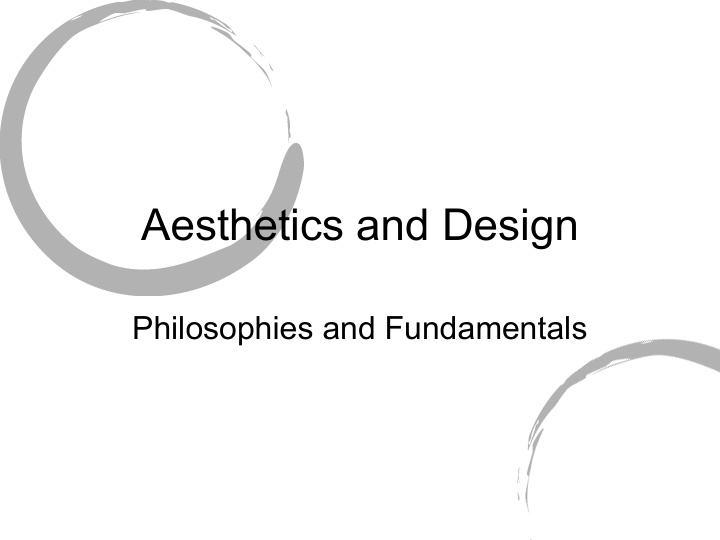



Aesthetics and Design Philosophies and Fundamentals
Aesthetics
Aesthetics • Not just Art Appreciation or Art Criticism • A Philosophical Exploration • What Do We Mean? • How Do We Know?
Aesthetics
Aesthetics
Aesthetics • John Hospers • Elements • Form • Expression • Symbol • Truth • Criticism • Value
Elements
Form
Expression
Symbol
Truth
Criticism
Value
Aesthetics • Denis Dutton • Expertise, Virtuosity • Nonutilitarian Pleasure • Style • Criticism • Imitation • Special Focus • Imagination
Expertise, Virtuosity
Nonutilitarian Pleasure
Style
Criticism
Imitation
Special Focus
Imagination
Aesthetics • Monroe C Beardsley • Unity • Complexity • Intensity
Unity
Complexity
Intensity
Aesthetics • Gordon Graham • Pleasure • Beauty • Emotion • Understanding
Pleasure
Beauty
Emotion
Understanding
Aesthetics • Arnold Isenberg • Verdict • Reason • Norm
Verdict
Reason
Norm
Aesthetics • Aristotle • Janet Murray • Poetics • New Poetics • Plot • Interactivity • Character • Immersion • Navigability • Theme • Transformation • Diction • Music • Spectacle
Poetics
Plot
Character
Theme
Diction
Music
Spectacle
New Poetics
Interactivity
Immersion
Navigability
Transformation
Design
Design • The Fundamental Act of Planning and Creating the Form of an Object • Putting Aesthetics into Play • Communication
Design
Design
Design • Poppy Evans and Mark Thomas • Design is a Language • Fundamental Principles and Elements • Principles are Organizational Rules • Primary and Secondary • Elements are Building Blocks • Content and Composition
Design
Design • Primary Principles • Unity and Variety • Hierarchy • Proportion • Secondary • Scale • Balance • Rhythm and Repetition • Proximity
Unity and Variety
Hierarchy
Proportion
Scale
Balance
Rhythm and Repetition
Proximity
Design • Elements • Shape and Space • Line • Size • Color • Texture • Typography
Shape and Space
Line
Size
Color
Texture
Typography
Design • Robin Williams • Four Basic Principles • Proximity • Alignment • Repetition • Contrast
Proximity
Alignment
Repetition
Contrast
Design • James Gordon Bennet • Beyond Static • Time • Interactivity • Additional Media
Beyond Static
Time
Interactivity
Additional Media
Design • Nathan Shedroff • Experience Design • Knowable • Reproducible • Designable
Experience Design
Knowable
Reproducible
Designable
Design • Elizabeth Resnick • Design Process • Define the Problem and Establish Objectives • Do the Research • Develop Ideas by Brainstorming • Analyze Ideas in Terms of Objectives • Implement Final
Design Process
Define the Problem
Establish Objectives
Do the Research
Brainstorm Ideas
Analyze Ideas
Implement Final
Scrum • Agile Development • Real Progress Scheduling • Playtesting • Iterative Design • Rapid Prototyping
Agile Development
Real Progress Scheduling
Playtesting
Iterative Design
Rapid Prototyping
Design
Design • Donald Norman • It’s not the Users Fault • Design Principles • Conceptual Models
It’s Not the Users Fault
Recommend
More recommend